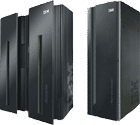Overview
PathPoint offers a breakthrough approach to mainframe application analysis. Only at runtime does the unique thread of application processing materialize … programs called, call statements issued, tables and files accessed. PathPoint traces and captures this application activity, dynamically at runtime for specified business transactions, enabling users to understand how their applications really work.
PathPoint reduces mainframe application analysis time … dramatically.
PathPoint was designed for application developers by application developers. The design concepts that make it suitible for rapid application analysis include:
| End User Business Oriented | PathPoint relates what the end users do directly to the underlying thread of processing in the application software. Simply point PathPoint to the end user performing a business activity by user ID or specify common information contained in the transaction messages that is specific to the business activity of interest. |
| Application Analyst Oriented | PathPoint reports information in terms most familiar to application developers, i.e., screens, transactions, programs, tables, files and IO statements. It relates that information to business procedures like “enter an order”. Using a top-down approach, analysts can see greater levels of detail to understand how a business activity was processed in consecutive user transactions. |
| Workstation Analysis | PathPoint application analysis is performed on a PC so that analysts are not burdened with problems associated with mainframe security and availability. |
| Dynamic Data Collection | PathPoint shows how the application actually works today in real time, not how it was designed many years ago or how someone remembers it should work. |
| Multiple Databases and Multiple MVS Subsystems | Unlike other tools that collect data for a predefined transaction, program or subsystem, PathPoint collects information across all these environments and automatically relates it to the original end user business activity. |
Features
Key features that enable application and performance analysts do their job more efficiently.
| Find Data | PathPoint enables one to find program statements that have specific values passed in CICS COMMAREA, transaction messages and host variable values and most data records. In addition, one can find specific values being tested in the conditional logic statement in source code (COBOL only). This information helps quickly find key values such as when a value is used to update a file/table. Example |
| DB2 Performance Analysis | Unique to PathPoint, PathPoint captures DB2 Explain information as well as DB2 scan statistics that include table and index, pages, rows, CPU time and elapsed time at the EB2 Explain step level for all program DB2 calls. With this detailed information, a DB2 performance analyst can very quick determine where time is spent processing tables and indexes, thus, isolating the cause of a performance problem. Example |
| Source Code Path Analysis (COBOL only) | PathPoint maps the captured statements to the compiled source code line numbers and paragraph names. It then determines the conditional if/then and program navigation logic that the program had to follow to get between consecutive statements. Thoses paths contain the business logic that manifests the business rules. This information significantly reduces time to locate program logic of interest. Example |
| Field Level Data Collection | PathPoint captures DB2 Host Variable values for DB2 calls. It also captures the CICS COMMAREA for CICS program calls, CICS transaction messages and most data records and maps them to fields defined in user supplied copybooks. One can locate the statements in the call path where a field is used and its value. This information is useful in problem determination. |
| Transaction Filtering | PathPoint captures transaction messages passed in the CICS COMMAREA or returned in CICS RETRIEVE staements for messages entering CICS from the web. One can easily select a sequence of web transactions for analysis. This saves a significant amount of time to locate transactions of interest. |
Click here for more detailed features.
Solutions
Understanding how an application works is fundamental to systems analysis requirement for:
| Application Modernization | Application Maintenance | Application Performance |
|---|---|---|
|
|
|
Technical Environments

| Operating System z/OS TP Monitors CICS |
Table/File Access VSAM DB2 IMS/DC Temporary Storage Transient Data |
Batch Environments DB2 IMS VSAM/non-VSAM Languages Any |

| Operating System Windows XP and above |
Table/File Access Relational database residing on the PC |
Resouorces 40 mb disk storage 4 mb Main Memory |
